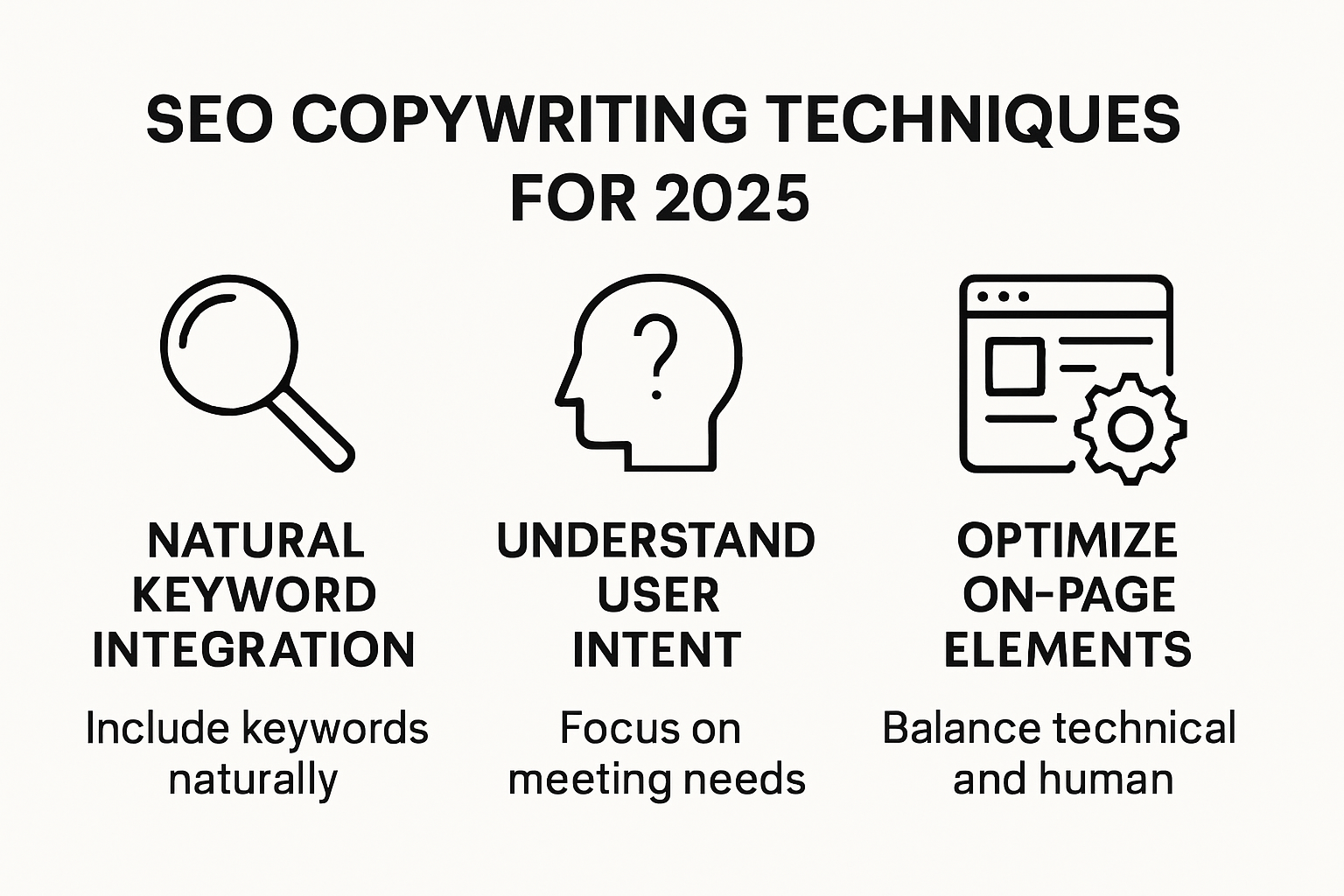Best SEO Copywriting Techniques for Success in 2025


SEO copywriting is getting smarter every year. The latest research shows that writing style alone can account for up to 27 percent of content performance, outshining even technical tweaks in many cases. Here’s the twist. The secret to success in 2025 is not just found in keywords or metadata but in blending deep expertise with natural, reader-friendly storytelling that search engines love.
Table of Contents
- Understanding SEO Copywriting Foundations
- Winning Keyword Research And Integration
- Crafting Engaging Content That Ranks
- Optimizing On-Page Elements For SEO Success
Quick Summary
| Takeaway | Explanation |
|---|---|
| Integrate Keywords Naturally | Use keywords in a way that feels conversational and seamless within the content, focusing on topic comprehensiveness rather than just exact-match keyword density. |
| Understand User Intent | Differentiate between various types of search motivations (informational, navigational, commercial, and transactional) and create content that matches these unique needs. |
| Optimize On-Page Elements | Implement structured header tags and craft engaging title tags and meta descriptions to improve discoverability and click-through rates on search engines. |
| Emphasize Technical and Human Balance | Combine technical optimization with engaging narratives that provide real value, ensuring content is both algorithm-friendly and appealing to readers. |
| Utilize Advanced Keyword Research Techniques | Employ sophisticated methods for keyword discovery and integration that reflect real-time user behavior and context, fostering a comprehensive content strategy. |

Understanding SEO Copywriting Foundations
SEO copywriting represents a strategic approach to creating content that simultaneously satisfies search engine algorithms and human readers. At its core, this technique blends persuasive writing skills with technical optimization strategies to generate content that ranks well and engages target audiences effectively.
The Science Behind Effective SEO Writing
Successful SEO copywriting goes beyond simply inserting keywords. Research analyzing academic articles revealed that writing style significantly impacts content performance, with function words and structural elements accounting for 13-27% of citation rates. This underscores the importance of crafting content that is not just keyword-rich but also structurally compelling.
Understanding search intent becomes crucial in this process. Writers must decode what users genuinely seek when entering specific search queries. This requires deep audience research, analyzing search patterns, and developing content that precisely matches user expectations. Effective SEO copywriting anticipates user questions and provides comprehensive, authoritative answers.
Strategic Content Development Techniques
Modern SEO copywriting demands a multifaceted approach. According to organizational analysis research, techniques like strategic keyword generation, intelligent link building, and directory submissions can substantially improve search rankings and business visibility.
Incorporating customer perspectives adds significant authenticity to content. Studies have shown that integrating customer reviews and real-world experiences can dramatically increase content attractiveness and click-through rates. This approach transforms copywriting from mere information delivery to a more engaging, trust-building communication method.
The most effective SEO copywriters understand that their primary goal is creating value. Content must solve problems, answer questions, and provide actionable insights. This means going beyond surface-level information and diving deep into topics with expertise and nuance.
Balancing Technical Optimization and Human Readability
Successful SEO copywriting walks a delicate line between technical optimization and natural, conversational writing. Keywords must be integrated seamlessly, avoiding the outdated practice of keyword stuffing. Modern search algorithms prioritize content that reads naturally while maintaining topical relevance.
This requires writers to develop a keen understanding of semantic search principles. Instead of focusing on exact-match keywords, the emphasis shifts to comprehensive topic coverage, using related terms and creating content clusters that demonstrate deep subject matter expertise.
By combining technical knowledge, strategic keyword usage, and a genuine commitment to providing reader value, SEO copywriters can create content that not only ranks well but also genuinely serves audience needs. The most successful approach treats search engines and human readers as equally important audiences, crafting content that is both discoverable and deeply engaging.
To clarify the key balance factors in effective SEO copywriting, here is a summary table outlining the main elements that need to be considered for technical optimization versus human readability:
| Element | Technical Optimization | Human Readability |
|---|---|---|
| Keyword Usage | Targeted, strategically placed | Natural, conversational |
| Structure (Headings, Format) | Uses proper tags for SEO structure | Easy-to-scan, logical flow |
| Semantic Coverage | Comprehensive use of related terms | Contextually rich, clear explanations |
| Tone & Style | Consistent, aligns with search intent | Engaging, reader-focused |
| Content Depth | Demonstrates expertise and authority | Answers questions, solves problems |
| Link Placement | Contextual internal/external linking for SEO | Adds value, trust, and usability |
Winning Keyword Research and Integration
Keyword research and integration represent the strategic backbone of effective SEO copywriting. This process goes far beyond simple word selection and involves sophisticated techniques that align content with user search behaviors and algorithmic preferences.
Advanced Keyword Discovery Strategies
Modern keyword research demands a nuanced approach. Research on cross-domain keyword extraction reveals sophisticated supervised ranking methods that can identify high-value keywords across different contexts. These advanced techniques move beyond traditional keyword tools by learning complex linguistic patterns and contextual relevance.
Successful keyword research requires understanding multiple dimensions. Writers must consider search volume, user intent, competition levels, and semantic relationships between terms. The goal is not just to identify keywords but to create a comprehensive content strategy that addresses user needs comprehensively.
Dynamic Keyword Generation and Adaptation
The emergence of AI-driven keyword research has transformed traditional approaches. Cutting-edge research demonstrates the potential of on-the-fly keyword generation systems that can dynamically monitor key performance indicators and adapt keyword strategies in real time. This represents a significant leap from static keyword lists to adaptive, responsive content strategies.
Academic research on keyword embeddings provides insights into more sophisticated keyword suggestion techniques. By leveraging advanced modeling approaches like Word2Vec and FastText, content creators can develop more nuanced understanding of keyword relationships and semantic connections.The most effective keyword strategies now incorporate multiple data points. This includes analyzing user search patterns, understanding long-tail keyword opportunities, and creating content clusters that comprehensively address specific topic areas. Success requires thinking beyond individual keywords to develop holistic content ecosystems.
Strategic Keyword Integration Techniques
Integrating keywords naturally remains a critical challenge for SEO copywriters. The days of keyword stuffing are long gone. Modern search algorithms demand contextually relevant, semantically rich content that provides genuine value to readers.
Effective keyword integration involves several sophisticated techniques. Writers must weave keywords seamlessly into content, ensuring they appear in critical locations like titles, headers, and opening paragraphs. However, the integration must feel natural and conversational, never forced or artificial.
Semantic search principles now guide keyword usage. This means focusing on topic comprehensiveness rather than exact-match keyword density. Content should demonstrate expertise by covering related concepts, using synonyms, and addressing various user questions within a given topic area.
The most successful SEO copywriters treat keywords as entry points to deeper, more comprehensive content. Each keyword becomes an opportunity to provide profound insights, solve user problems, and establish topical authority. By combining technical precision with creative storytelling, writers can create content that both ranks well and genuinely serves audience needs.

Crafting Engaging Content That Ranks
Creating content that simultaneously captivates readers and satisfies search engine algorithms requires a strategic blend of creativity, technical understanding, and audience insight. Modern SEO copywriting demands more than just keyword placement it requires crafting narratives that genuinely connect with readers while meeting complex algorithmic requirements.
Understanding User Intent and Content Architecture
Research on digital content strategies highlights the critical importance of decoding user intent. Content creators must distinguish between different search motivations: informational, navigational, commercial, and transactional. Each intent requires a unique approach to content development, ensuring that the material precisely matches user expectations.Successful content architecture involves creating comprehensive, layered information that addresses multiple user questions within a single piece. This means developing content that not only answers the primary query but also anticipates and resolves related questions, creating a holistic resource that provides genuine value.
Below is a comparison table summarizing the main types of user intent and the content strategies best suited for each, as discussed in this section:
| User Intent | Description | Content Strategy Approach |
|---|---|---|
| Informational | User seeks knowledge or answers to a question | Provide clear, in-depth explanations |
| Navigational | User wants to find a specific site or page | Offer direct, easy navigation cues |
| Commercial | User is exploring products or services | Present comparisons, reviews, guides |
| Transactional | User is ready to make a purchase or complete an action | Highlight CTAs, simplify next steps |
Writing Style and Engagement Techniques
Academic research analyzing writing styles reveals fascinating insights into content effectiveness. The study demonstrated that writing style accounts for 13-27% of content impact, with function words and structural elements playing a crucial role in reader engagement. This underscores the need for writers to pay meticulous attention to their linguistic choices.Effective engagement requires a conversational yet authoritative tone. Writers must balance technical accuracy with accessibility, breaking down complex concepts into digestible, compelling narratives. This involves using clear language, creating logical content flow, and incorporating storytelling techniques that maintain reader interest.
Ethical and Adaptive Content Strategies
A comprehensive literature review on digital copywriting emphasizes the growing significance of personalization and ethical considerations in content creation. Modern copywriters must develop adaptable strategies that respect user privacy, provide authentic value, and align with evolving technological and societal expectations.Personalization has become a key differentiator in content strategy. This means moving beyond generic information to create targeted, contextually relevant content that speaks directly to specific audience segments. Writers must leverage data insights while maintaining a human touch, creating content that feels both intelligent and empathetic.
The most successful SEO copywriters understand that ranking is not the ultimate goal content quality is. Search engines increasingly prioritize materials that demonstrate expertise, authoritativeness, and trustworthiness. This requires going beyond surface-level information to provide deep, nuanced insights that genuinely help readers solve problems or understand complex topics.
By combining technical SEO knowledge, sophisticated writing techniques, and a genuine commitment to user value, content creators can develop materials that not only rank well but also establish meaningful connections with their audience. The future of SEO copywriting lies in creating content that is simultaneously intelligent, engaging, and profoundly useful.
Optimizing On-Page Elements for SEO Success
On-page SEO optimization represents the critical foundation for improving search engine visibility and user engagement. Strategic manipulation of website elements can dramatically enhance content discoverability and performance across digital platforms.
Mastering Header Tag Hierarchy
Research on effective SEO techniques demonstrates the paramount importance of structured header tags. Proper implementation involves creating a logical content hierarchy that guides both users and search engine algorithms through information architecture.Header tag optimization requires meticulous planning. Writers must use a single H1 tag representing the primary content theme, followed by H2 tags for major sections and H3 tags for subsections. This structured approach provides clear semantic signals about content organization and improves overall readability.
Crafting Compelling Title Tags and Meta Descriptions
Expert analysis on digital marketing strategies reveals that title tags and meta descriptions play a crucial role in improving click-through rates. These elements serve as the first interaction point between content and potential readers in search engine results pages.Effective title tags should be concise, descriptive, and include target keywords strategically. Meta descriptions must provide a compelling summary that entices users to click, balancing informative content with persuasive language. The goal is to create micro-content that stands out in competitive search environments.
Advanced Structured Data and Technical Optimization
Technical SEO research highlights the growing significance of structured data markup. By implementing schema markup, websites can provide search engines with enhanced context about content, potentially improving visibility through rich snippets and detailed search results.Structured data goes beyond simple keyword placement. It involves creating complex information networks that help search algorithms understand content relationships, context, and specific attributes. This might include marking up product reviews, event details, FAQ sections, and other specialized content types.
Optimizing on-page elements requires a holistic approach that combines technical precision with creative communication. Writers and SEO professionals must continuously adapt to evolving search engine algorithms, focusing on creating valuable, well-structured content that serves user needs while meeting technical requirements.
The most successful on-page SEO strategies treat optimization as an ongoing process of refinement. This means regularly analyzing performance metrics, understanding user behavior, and making data-driven adjustments to content structure, metadata, and technical elements. By maintaining a dynamic, user-centric approach, websites can achieve sustained visibility and engagement in an increasingly competitive digital landscape.
Frequently Asked Questions
What are the key elements of effective SEO copywriting in 2025?
Effective SEO copywriting in 2025 involves integrating keywords naturally, understanding user intent, optimizing on-page elements, and balancing technical optimization with human readability to create engaging content that serves both search engines and readers.
How can I conduct advanced keyword research for my content?
Advanced keyword research can be conducted by using sophisticated techniques such as analyzing user search behavior, leveraging AI-driven tools for dynamic keyword generation, and considering semantic relationships between terms to create holistic content strategies.
What is the importance of user intent in SEO copywriting?
Understanding user intent is crucial in SEO copywriting because it allows content creators to tailor their material to different search motivations, ensuring the content matches what users are actually seeking, whether it's informational, navigational, commercial, or transactional.
How can I optimize my on-page elements for better SEO performance?
To optimize on-page elements for SEO, focus on mastering header tag hierarchy, crafting compelling title tags and meta descriptions, and implementing structured data markup to enhance content discoverability and engagement in search results.
Ready to Break Through SEO Copywriting Barriers?
If you are struggling to keep up with the latest SEO copywriting demands for 2025, you are not alone. Mastering keyword integration and creating deeply engaging content is tough, especially when balancing technical details with real user value. Many businesses wish their content could rank higher and truly connect with audiences without endless manual effort. Want to see results faster?

Take charge of your SEO strategy with BabyLoveGrowth.ai. Our platform automatically handles advanced keyword research, crafts SEO-optimized articles, and builds a custom 30-day content plan that directly addresses the challenges explored in this guide. Let our AI-driven business analysis and content automation help you outperform the competition, save hours each week, and produce content that truly resonates. Visit BabyLoveGrowth.ai now and get ready to see meaningful improvements in your organic traffic and rankings.
Recommended
- SEO Trends for 2024: Key Shifts Every Marketer Should Know
- SEO Strategies for Bloggers: Proven Tactics for 2025 Success
- The Importance of Organic Traffic for Business Growth in 2025
- How to Write SEO Titles in 2025: Easy Guide for Maximum Impact
- Winning SEO Outreach Strategies for 2025: Guide for SMBs
- SEO Importance for Businesses in 2025: Key Benefits and Strategies
Smart SEO,
Faster Growth!
Most Read Articles

Generative Engine Optimization (GEO)
Learn how Generative Engine Optimization (GEO) helps your content rank in AI search engines like ChatGPT and Google AI. This comprehensive guide explains the differences between SEO and GEO, why it matters for your business, and practical steps to implement GEO strategies for better visibility in AI-generated responses.

Track LLM Traffic in Google Analytics 4 (GA4)
Learn how to track and analyze traffic from AI sources like ChatGPT, Claude, Perplexity, and Google Gemini in Google Analytics 4. This step-by-step guide shows you how to set up custom filters to monitor AI-driven traffic and make data-driven decisions for your content strategy.

How to Humanize AI Text with Instructions
Learn practical techniques to make AI-generated content sound more natural and human. This guide covers active voice, direct addressing, concise writing, and other proven strategies to transform robotic text into engaging content.

Open AI Revenue and Statistics (2024)
Comprehensive analysis of OpenAI financial performance, user engagement, and market position in 2023. Discover key statistics including $20B valuation, $1B projected revenue, and 100M+ monthly active users.